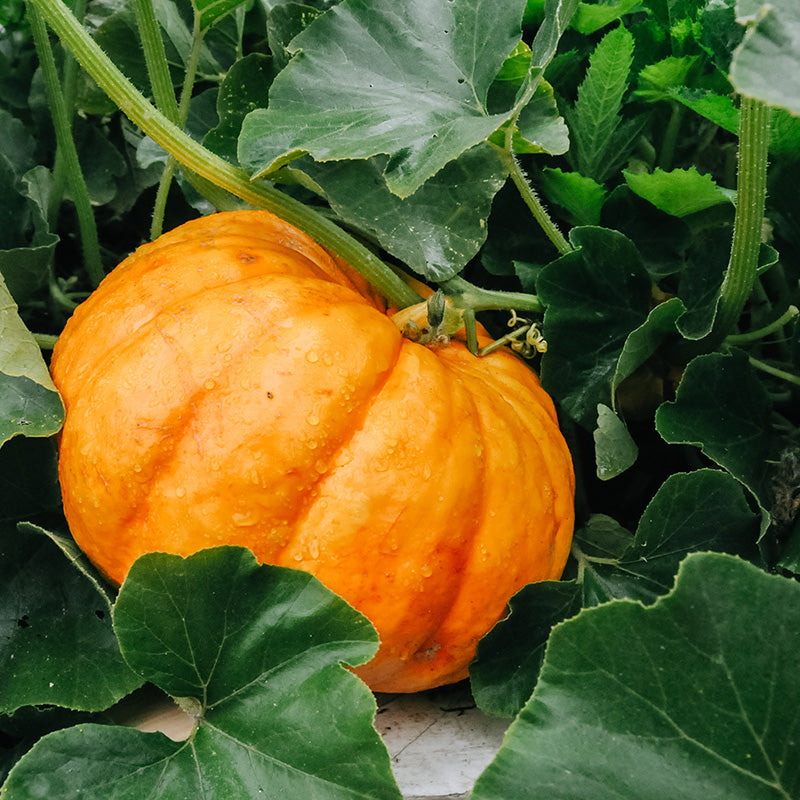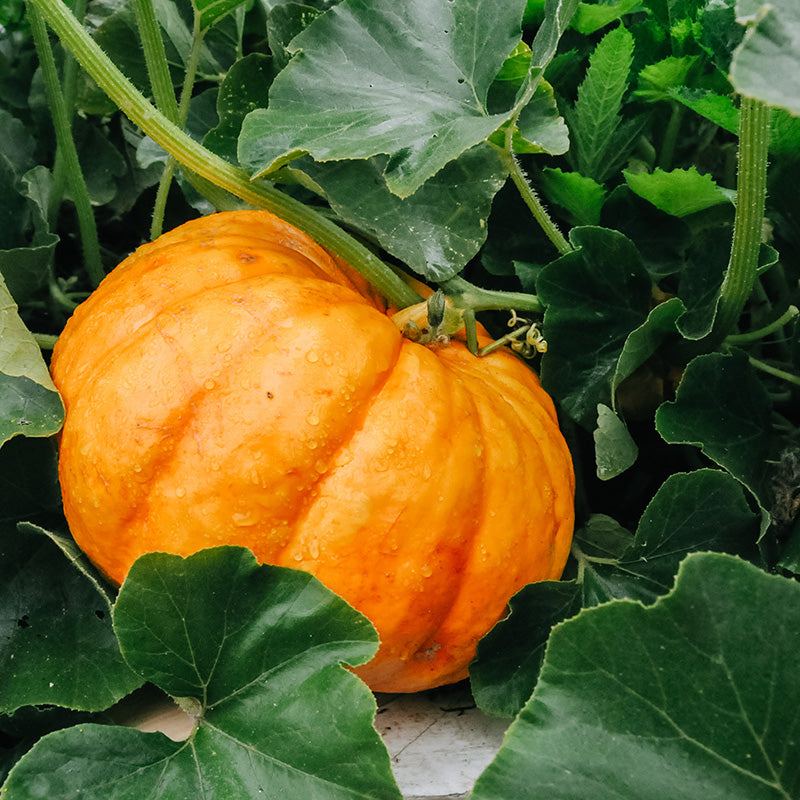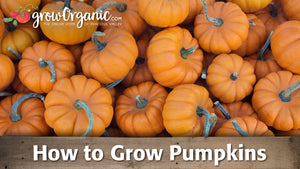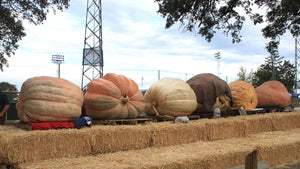Item Number: PV144
Organic Cinderella Pumpkin
Organic Cinderella Pumpkin
Distinctive Ribs, Rich Flavor: Cinderella's Delight!
Named Rouge Vif d'Etampes, this French heirloom, popular in 1880s Parisian markets, combines ornamental beauty with excellent sweet flavor. These 20 lb pumpkins, grown on bushy vines, are not only visually appealing but also good keepers, adding both aesthetics and taste to your harvest.
Sustainably grown in 2.75" pots
Preparing the Soil
Cinderella pumpkins thrive in well-drained, fertile soil with a pH level between 6.0 and 7.0. Before planting, prepare the soil by amending it with organic matter such as compost or aged manure to improve its texture and fertility. Remove any weeds and debris from the planting area to create a clean and healthy growing environment for your Cinderella pumpkins.
Planting Cinderella Pumpkins
Cinderella pumpkins are warm-season crops that require plenty of sunlight to thrive. Plant starts in late spring or early summer, once the soil has warmed up to at least 70°F (21°C). Space plants 2 to 3 feet apart in rows spaced 4 to 6 feet apart to allow for adequate air circulation and room for vine growth.
Watering and Care
Cinderella pumpkins require consistent moisture throughout the growing season, especially during hot, dry weather. Water the plants deeply once or twice a week, providing enough water to keep the soil evenly moist but not waterlogged. Avoid overhead watering, as wet foliage can promote fungal diseases. Mulching around the base of the plants can help retain soil moisture and suppress weeds.
Fertilizing
Cinderella pumpkins are heavy feeders and benefit from regular fertilization throughout the growing season. Apply a balanced fertilizer or compost tea every 3 to 4 weeks to provide essential nutrients for healthy growth and fruit development. Be sure to follow the manufacturer's instructions for application rates and timing.
Training and Support
Cinderella pumpkins are vining plants that benefit from support and training to keep the fruit off the ground and prevent rotting. Consider using trellises, cages, or stakes to support the vines and encourage upward growth. Prune the vines as needed to remove any dead or diseased foliage and promote air circulation around the plants.
Pest and Disease Management
Cinderella pumpkins are susceptible to a variety of pests and diseases, including aphids, cucumber beetles, powdery mildew, and bacterial wilt. Monitor your plants regularly for signs of pest infestations or disease symptoms and take appropriate action to control them. Use insecticidal soap or neem oil to treat aphids and cucumber beetles, and apply fungicides to prevent powdery mildew.
Harvesting Cinderella Pumpkins
Cinderella pumpkins are ready to harvest when they develop a deep orange color and a hard, woody stem. The skin should resist puncture when pressed with your fingernail, indicating that the pumpkin is fully mature. Use a sharp knife or pruning shears to cut the pumpkin from the vine, leaving a few inches of stem attached. Cinderella pumpkins can be stored in a cool, dry place for several months.
Growing Cinderella pumpkins can be a rewarding experience that allows you to enjoy unique and flavorful pumpkins right from your garden. By following the tips and guidelines outlined in this guide, you can successfully cultivate Cinderella pumpkins and enjoy a bountiful harvest of beautiful and delicious fruits all season long.





Check Your Zone Compatibility:
Compatible with your zone.
Growing Zone for
,

Our Guarantee To You
Since 1976, we've served our customers at every stage of growing. Please contact us at any time. We are happy to support and assist you.
Description
Description
Named Rouge Vif d'Etampes, this French heirloom, popular in 1880s Parisian markets, combines ornamental beauty with excellent sweet flavor. These 20 lb pumpkins, grown on bushy vines, are not only visually appealing but also good keepers, adding both aesthetics and taste to your harvest.
Sustainably grown in 2.75" pots
Preparing the Soil
Cinderella pumpkins thrive in well-drained, fertile soil with a pH level between 6.0 and 7.0. Before planting, prepare the soil by amending it with organic matter such as compost or aged manure to improve its texture and fertility. Remove any weeds and debris from the planting area to create a clean and healthy growing environment for your Cinderella pumpkins.
Planting Cinderella Pumpkins
Cinderella pumpkins are warm-season crops that require plenty of sunlight to thrive. Plant starts in late spring or early summer, once the soil has warmed up to at least 70°F (21°C). Space plants 2 to 3 feet apart in rows spaced 4 to 6 feet apart to allow for adequate air circulation and room for vine growth.
Watering and Care
Cinderella pumpkins require consistent moisture throughout the growing season, especially during hot, dry weather. Water the plants deeply once or twice a week, providing enough water to keep the soil evenly moist but not waterlogged. Avoid overhead watering, as wet foliage can promote fungal diseases. Mulching around the base of the plants can help retain soil moisture and suppress weeds.
Fertilizing
Cinderella pumpkins are heavy feeders and benefit from regular fertilization throughout the growing season. Apply a balanced fertilizer or compost tea every 3 to 4 weeks to provide essential nutrients for healthy growth and fruit development. Be sure to follow the manufacturer's instructions for application rates and timing.
Training and Support
Cinderella pumpkins are vining plants that benefit from support and training to keep the fruit off the ground and prevent rotting. Consider using trellises, cages, or stakes to support the vines and encourage upward growth. Prune the vines as needed to remove any dead or diseased foliage and promote air circulation around the plants.
Pest and Disease Management
Cinderella pumpkins are susceptible to a variety of pests and diseases, including aphids, cucumber beetles, powdery mildew, and bacterial wilt. Monitor your plants regularly for signs of pest infestations or disease symptoms and take appropriate action to control them. Use insecticidal soap or neem oil to treat aphids and cucumber beetles, and apply fungicides to prevent powdery mildew.
Harvesting Cinderella Pumpkins
Cinderella pumpkins are ready to harvest when they develop a deep orange color and a hard, woody stem. The skin should resist puncture when pressed with your fingernail, indicating that the pumpkin is fully mature. Use a sharp knife or pruning shears to cut the pumpkin from the vine, leaving a few inches of stem attached. Cinderella pumpkins can be stored in a cool, dry place for several months.
Growing Cinderella pumpkins can be a rewarding experience that allows you to enjoy unique and flavorful pumpkins right from your garden. By following the tips and guidelines outlined in this guide, you can successfully cultivate Cinderella pumpkins and enjoy a bountiful harvest of beautiful and delicious fruits all season long.
Shipping Information
Shipping Information
Cannot ship to the following states: AK, HI, PR, VI, GU
Shipping Weight: 0.5 lb
Dimensions: 6.0"L x 2.75"W x 2.75"H
Features
Features
Characteristics
Characteristics
Planting & Care
Planting & Care
Soil & Water: Pumpkins prefer loam or sandy soil high in organic matter to hold large amounts of moisture. The plants require heavy and even water for best development. The preferred soil pH is between 6.0-7.0.
Planting & Growing: Plant starts in late spring or early summer, once the soil has warmed up to at least 70°F (21°C). Space plants 2 to 3 feet apart in rows spaced 4 to 6 feet apart to allow for adequate air circulation and room for vine growth. Place a board underneath the fruit to help prevent rotting.
Harvesting & Storage: For immediate use, harvest when the skin loses its sheen. For storage, harvest pumpkins when fully mature. Cut the fruit from the vine, leaving 4"-6" of stem. Cure for storage by setting in a warm, dry location for 1-2 weeks.
Useful Information
Useful Information
Guarantee
Guarantee
We guarantee the perishable items we sell to be in good, viable condition when we sell them. Perishable items include, but are not limited to, garlic bulbs, flower bulbs, seed potatoes, onion sets & transplants, potted or bare root trees, vegetable crowns, etc. If your perishable item arrives in substandard condition, take photographs and please contact us within 3 days of the purchase date (or delivery date) and we will provide you with a refund of the purchase price (excluding shipping costs), or a replacement. Accordingly, we urge you to open any boxes marked as ""Perishable"" immediately upon receiving them and inspect the shipment thoroughly (do not crack open heads of garlic, we do not accept claims on cracked garlic). Because some perishable items can deteriorate very quickly, we cannot accept any claims beyond the 3-day time frame as it becomes too difficult to determine if these items were delivered in substandard condition, or if they turned into such substandard condition because of having been improperly cared for or stored once delivered.
Share




